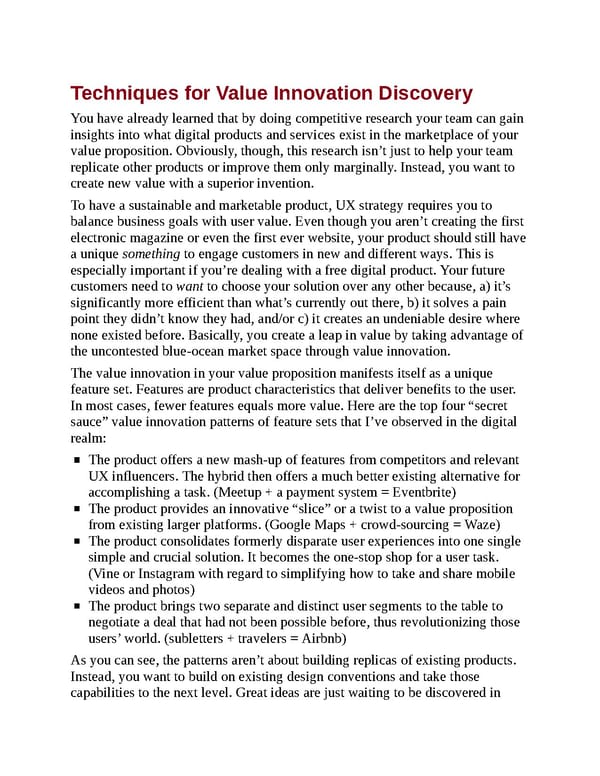Techniques for Value Innovation Discovery You have already learned that by doing competitive research your team can gain insights into what digital products and services exist in the marketplace of your value proposition. Obviously, though, this research isn’t just to help your team replicate other products or improve them only marginally. Instead, you want to create new value with a superior invention. To have a sustainable and marketable product, UX strategy requires you to balance business goals with user value. Even though you aren’t creating the first electronic magazine or even the first ever website, your product should still have a unique something to engage customers in new and different ways. This is especially important if you’re dealing with a free digital product. Your future customers need to want to choose your solution over any other because, a) it’s significantly more efficient than what’s currently out there, b) it solves a pain point they didn’t know they had, and/or c) it creates an undeniable desire where none existed before. Basically, you create a leap in value by taking advantage of the uncontested blue-ocean market space through value innovation. The value innovation in your value proposition manifests itself as a unique feature set. Features are product characteristics that deliver benefits to the user. In most cases, fewer features equals more value. Here are the top four “secret sauce” value innovation patterns of feature sets that I’ve observed in the digital realm: The product offers a new mash-up of features from competitors and relevant UX influencers. The hybrid then offers a much better existing alternative for accomplishing a task. (Meetup + a payment system = Eventbrite) The product provides an innovative “slice” or a twist to a value proposition from existing larger platforms. (Google Maps + crowd-sourcing = Waze) The product consolidates formerly disparate user experiences into one single simple and crucial solution. It becomes the one-stop shop for a user task. (Vine or Instagram with regard to simplifying how to take and share mobile videos and photos) The product brings two separate and distinct user segments to the table to negotiate a deal that had not been possible before, thus revolutionizing those users’ world. (subletters + travelers = Airbnb) As you can see, the patterns aren’t about building replicas of existing products. Instead, you want to build on existing design conventions and take those capabilities to the next level. Great ideas are just waiting to be discovered in
 UX Strategy: How to Devise Innovative Digital Products that People Want Page 146 Page 148
UX Strategy: How to Devise Innovative Digital Products that People Want Page 146 Page 148